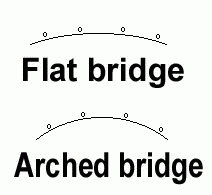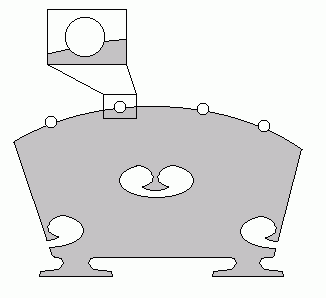The Bridge
( 26th March1999 version 0.3 )
Link to Casa
del Sol : Bridge Maintenance article
Flat versus arched
 The
bridge is a very important part of the violin setup. A good bridge should
allow sufficient curvature in order to play the D and A strings in high ( say
7th ) position ( without touching any adjacent strings ), as well as allow
easy and convenient access for three string chords or triple stops. If a
bridge is too arched, then the G string will be difficult and awkward to reach
; the arm will soon tire of the excessively high position required to play it.
Also too arched a bridge will not permit chords to be played sounding all the
strings / notes as together as possible. In other words, a very broken chord
will result. It follows that a bridge should be as flat as possible, as long
as the D and A strings can be played without touching the G or E strings.
The
bridge is a very important part of the violin setup. A good bridge should
allow sufficient curvature in order to play the D and A strings in high ( say
7th ) position ( without touching any adjacent strings ), as well as allow
easy and convenient access for three string chords or triple stops. If a
bridge is too arched, then the G string will be difficult and awkward to reach
; the arm will soon tire of the excessively high position required to play it.
Also too arched a bridge will not permit chords to be played sounding all the
strings / notes as together as possible. In other words, a very broken chord
will result. It follows that a bridge should be as flat as possible, as long
as the D and A strings can be played without touching the G or E strings.
Advanced players can cope with a flatter bridge - and with less margin of
error in bowing a single string. If a beginner plays with this flat bridge, he
or she will probably end up touching the adjacent strings accidentally most of
the time. A flat bridge has the advantage of a high E and G. In general the
right arm will not have to travel in the vertical plane too much to change
string. The strings should also be placed quite close to one another, so that
they are easily reached.
A poor bridge has an irregular curvature. In other words, the distance
required to cross from double stops on a G&D to double stops on the D&A
is unequal to the distance needed to go from D&A to A&E. In this case
uneven playing will result - and certain 3 string crossing bowing patterns
cannot be played successfully. It is important to have a regular and even curve
throughout the bridge.
The string grooves
 Left : An important
point about the grooves under the strings. Your string must essentially lie on
the surface of the bridge, and must never be buried deeply inside the bridge
itself. The diagram shows the correct amount of string which should lie above
the groove. This is important in order to allow the string free movement and
vibrations. Remember to coat the grooves with graphite / lead using a pencil,
as this will ensure the string surface doesn't get damaged by the friction
produced when tuning up. You can also coat the nut ( at the top of the
fingerboard ) with graphite for the same reasons.
Left : An important
point about the grooves under the strings. Your string must essentially lie on
the surface of the bridge, and must never be buried deeply inside the bridge
itself. The diagram shows the correct amount of string which should lie above
the groove. This is important in order to allow the string free movement and
vibrations. Remember to coat the grooves with graphite / lead using a pencil,
as this will ensure the string surface doesn't get damaged by the friction
produced when tuning up. You can also coat the nut ( at the top of the
fingerboard ) with graphite for the same reasons.